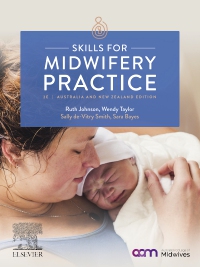
Skills for Midwifery Practice Australian & New Zealand edition - E-Book, 2nd Edition
Elsevier eBook on VitalSource

-
- Endorsed by the Australian College of Midwives
- Step-by-step instructions for each skill
- Images and diagrams to aid understanding
- A woman-centred approach and cultural considerations throughout
- Models of midwifery care (Continuity of Care and Lead Maternity Carer’s Model)
- Australian/NZ specific guidelines, policies, statistics, terminology and medication administration guidelines
- An eBook included in all print purchases
-
PART 1: GENERAL SKILLS
Section 1: Principles of infection control Chapter 1: Standard Precautions and hand hygiene Chapter 2: Asepsis Chapter 3: Principles of hygiene needs
Section 2: Vital signs Chapter 4: Temperature Chapter 5: Pulse Chapter 6: Respiration Chapter 7: Blood pressure Chapter 8: Neurological assessment
Section 3: Screening and Testing Chapter 9: Screening tests Chapter 10: Venepuncture Chapter 11: Cannulation Chapter 12: Obtaining Swabs Chapter 13: Use of Speculum Chapter 14: Capillary sampling
Section 4: Principles of elimination management Chapter 15: Micturition and catheterisation Chapter 16: Urine samples Chapter 17: Defecation and stool specimens
Section 5: Principles of drug administration Chapter 18: Medication administration: Legal aspects, pharmacology and anaphylaxis Chapter 19: Oral Chapter 20: Per vaginum Chapter 21: Per rectum Chapter 22: By injection Chapter 23: Intravenous medications and intravenous therapy Chapter 24: Blood and iron transfusion Chapter 25: Inhalation
Section 6: Skills for supporting antenatal wellbeing Chapter 26: Building a therapeutic relationship Chapter 27: Abdominal examination during pregnancy Chapter 28: Interprofessional working to optimise women's antenatal care
Section 7: Skills for preparing women for labour, birth and early parenting Chapter 29: Facilitating learning in expectant and new parents
PART 2: WORKING WITH THE WOMAN AND BABY DURING LABOUR AND BIRTH
Section 8: Monitoring well-being in early labour Chapter 30: Principles of intrapartum skills: first-stage issues Chapter 31: Abdominal examination during labour Chapter 32: Membrane Sweep Chapter 33: Fetal Heart Monitoring Chapter 34: Non-pharmacological pain relief Chapter 35: Water immersion for labour and birth Chapter 36: Birth at Home
Section 9: Monitoring well-being in established labour Chapter 37: Fetal Blood Sampling Chapter 38: Epidural analgesia
Section 10: Monitoring wellbeing during the expulsive phase Chapter 39: Intrapartum skills in the second stage Chapter 40: Care of the perineum before and during birth Chapter 41: Assisted and operative birth Chapter 42: Maternal and newborn resuscitation
Section 11: Monitoring wellbeing during and after the third stage Chapter 43: Principles of intrapartum skills: third stage Chapter 44: Postpartum haemorrhage Chapter 45: Examination and repair of the genital tract following birth
PART 3: WORKING WITH THE WOMAN AND BABY AFTER BIRTH
Section 12: Skills for optimising the woman's and baby's physiological wellbeing Chapter 46: Promoting physiological stability in the mother-baby dyad immediately after normal term birth Chapter 47: Caring for a woman after a caesarean section Chapter 48: Caring for the baby's physiological wellbeing after birth
Section 13: Skills for supporting the woman to feed her baby Chapter 49: Supporting the woman to initiate breastfeeding Chapter 50: Supporting the woman who chooses to formula feed
PART 4: CARE OF SELF AND OTHERES
Section 14: Skills for working safely Chapter 51: Self Care Chapter 52: Manual handling Chapter 53: Workplace Health and Safety